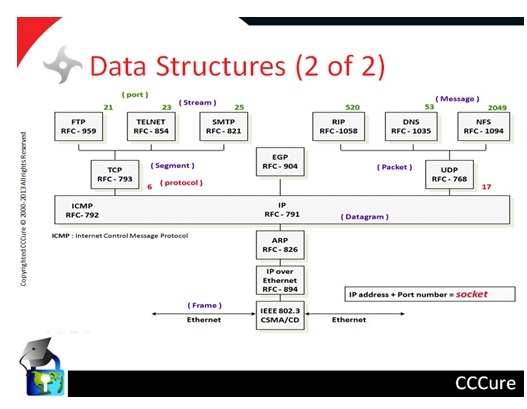What is the proper term to refer to a single unit of Ethernet data at the link layer of the DoD TCP model ?
A. Ethernet Segment.
B. Ethernet Datagram.
C. Ethernet Frame.
D. Ethernet Packet.
A. Ethernet Segment.
B. Ethernet Datagram.
C. Ethernet Frame.
D. Ethernet Packet.
Correct Answer: C
Explanation:
Ethernet is frame based network technology. See below a few definitions from RFC 1122:
SEGMENT A segment is the unit of end-to-end transmission in the TCP protocol. A segment consists of a TCP header followed by application data. A segment is transmitted by encapsulation inside an IP datagram.
PACKET A packet is the unit of data passed across the interface between the internet layer and the link layer. It includes an IP header and data. A packet may be a complete IP datagram or a fragment of an IP datagram.
FRAME A frame is the unit of transmission in a link layer protocol, and consists of a link-layer header followed by a packet.
The following answers are incorrect:
Ethernet segment. Is incorrect because Ethernet segment is a distractor, TCP segment would be the correct terminology. Ethernet is a frame based network technology,
Ethernet datagram. Is incorrect because Ethernet datagram is a distractor, IP datagram would be the correct terminology. Ethernet is a frame based network technology
Ethernet packet. Is incorrect because Ethernet packet is a distractor, a Packet is a group of information so would not be a “single unit”. Ethernet is a frame based network technology.
Look at the diagrams below that were extracted from my Security+ Computer Based Tutorial.
TCP/IP Data Structures

IMPORTANT NOTE: The names used on the diagram above are from RFC 1122 which describe the DOD Model. Vendors and Books may use slightly different names or even number of layers.

TCP/IP Data Structure
The following Reference(s) were used for this question: Wikipedia http://en.wikipedia.org/wiki/Ethernet
SEGMENT A segment is the unit of end-to-end transmission in the TCP protocol. A segment consists of a TCP header followed by application data. A segment is transmitted by encapsulation inside an IP datagram.
PACKET A packet is the unit of data passed across the interface between the internet layer and the link layer. It includes an IP header and data. A packet may be a complete IP datagram or a fragment of an IP datagram.
FRAME A frame is the unit of transmission in a link layer protocol, and consists of a link-layer header followed by a packet.
The following answers are incorrect:
Ethernet segment. Is incorrect because Ethernet segment is a distractor, TCP segment would be the correct terminology. Ethernet is a frame based network technology,
Ethernet datagram. Is incorrect because Ethernet datagram is a distractor, IP datagram would be the correct terminology. Ethernet is a frame based network technology
Ethernet packet. Is incorrect because Ethernet packet is a distractor, a Packet is a group of information so would not be a “single unit”. Ethernet is a frame based network technology.
Look at the diagrams below that were extracted from my Security+ Computer Based Tutorial.
TCP/IP Data Structures

IMPORTANT NOTE: The names used on the diagram above are from RFC 1122 which describe the DOD Model. Vendors and Books may use slightly different names or even number of layers.

TCP/IP Data Structure
The following Reference(s) were used for this question: Wikipedia http://en.wikipedia.org/wiki/Ethernet